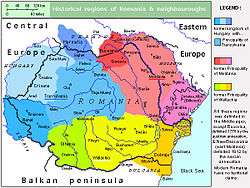Historical regions of Romania



The historical regions of Romania are located in Southeastern Europe.[1] Romania came into being through the unification of two principalities, Wallachia and Moldavia in 1862.[2] The new unitary state extended over further regions at various times during the late 19th and 20th centuries, including Dobruja in 1878, and Transylvania in 1918.[3]
- Muntenia (Greater Wallachia): part of Wallachia (which united with Moldavia in 1859 to create modern Romania);
- Oltenia (Lesser Wallachia): the territory between the rivers Danube and Olt and the Southern Carpathian became part of the Principality of Wallachia in the early 14th century.[4]
- Western Moldavia: part of Moldavia (which united with Wallachia in 1859 to create modern Romania);
- Bucovina: in Romania between 1918 and World War II, today divided between Romania and Ukraine;
- Bessarabia (eastern Moldavia) (including Budjak): in Romania between 1918 and World War II, today divided between Moldova and Ukraine; also, southern Bessarabia in Romania, between 1859 and 1878;
- Hertza region: in Romania until the World War II, today in Ukraine.
- Northern Dobrogea (including Snake Island): today in Romania (excepting some Danubian islands and the Snake Island which were incorporated in the USSR in 1948, and became part of Ukraine since 1991);
- Southern Dobruja or Cadrilater: in Romania between 1913 and 1940, today in Bulgaria.
Wallachia, western Moldavia, and Dobruja are sometimes referred collectively as the Regat (The Kingdom), as they formed the Romanian "Old" Kingdom before World War I.
![]() Transylvania (the term sometimes encompasses not only Transylvania proper, but also the historical regions of Crișana, Maramureș, and Romanian part of Banat):
Transylvania (the term sometimes encompasses not only Transylvania proper, but also the historical regions of Crișana, Maramureș, and Romanian part of Banat):
- Transylvania proper (the former principality of Transylvania): united with Romania in 1918;
- Banat: since 1918 divided between Romania, Serbia and Hungary;
- Crișana: the region bordered by the rivers Mureș and Someș and the Apuseni Mountains became part of Romania in 1918.[5]
- Maramureș: the mountainous northwestern region became part of Romania in 1918.[6]
Transylvania is divided into several ethnographic regions.
During or after World War II Romania lost some of the above-mentioned regions: Bessarabia, Northern Bukovina and Hertza region (in 1940), Southern Dobruja (in 1940), and the Snake Island (in 1948). Transnistria was also occupied for a short time during World War II by Romania (from 1941 to 1944).
See also
- History of Romania
- Molotov–Ribbentrop Pact
- Development regions of Romania — divisions used currently and which are not based on the borders of historical regions;
- Counties of Romania
- Movement for the unification of Romania and Moldova
References
- ↑ Treptow & Popa 1996, p. 1, Map 2.
- ↑ Treptow & Popa 1996, p. 13.
- ↑ Treptow & Popa 1996, pp. 14-15.
- ↑ Treptow & Popa 1996, p. 151.
- ↑ Treptow & Popa 1996, pp. 80-81.
- ↑ Treptow & Popa 1996, pp. 125-126.
Sources
- Treptow, Kurt W.; Popa, Marcel (1996). Historical Dictionary of Romania. Scarecrow Press, Inc. ISBN 0-8108-3179-1.